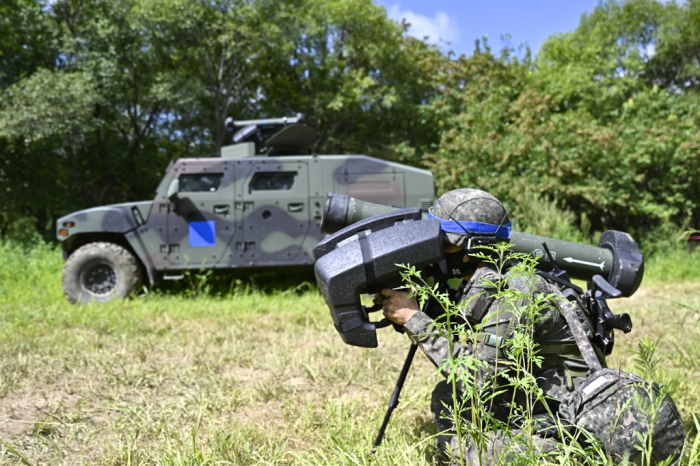
A South Korean army soldier operates LIG Nex1’s Raybolt in a drill An anti-tank guided weapon produced by South Korean defense exporter LIG Nex1 Co. is in the spotlight as Ukraine said its forces destroyed Russian armored vehicles with US-made Javelin missiles.On the other hand, South Korean defense makers, which are seeking exports of armored cars, face growing doubts over the utility of the military vehicles in war, given the mounting losses of Russian military assets.Ukrainian President Volodymyr Zelenskyy reportedly called on South Korea’s government to provide the country with LIG Nex1’s Raybolt, an anti-tank guided missile, and other weapons, according to defense industry sources in Seoul on Friday.The Raybolt is a portable missile similar to the Javelin, known for its performance against Russia after its invasion of Ukraine. The US weapon is regarded as key to checking Russia’s advance as Ukraine’s government recently announced that the country has destroyed 211 tanks, 862 armored vehicles and 355 other military cars of Russian troops. Destroyed Russian armored vehicles are left unattended on the road outside Kyiv, Ukraine’s capital on April 1, 2022 (Courtesy of AP, Yonhap) Javelin’s brand power had been too strong for Raybolt to compete. But the war in Ukraine has boosted interest in anti-tank guided missiles, which is expected to increase sales of the South Korean weapon.Raybolt has similar warhead power and range to Javelin's missile, while its visible light camera allows a shooter to aim and launch day and night. Its prices are reportedly only about a third Javelin's price tag, speculated at around 100 million won ($81,400) per unit.“The war is predicted to ramp up demand for anti-tank missiles,” said a South Korean defense industry source said. “Raybolt is likely to benefit from the trend as its performance is similar to Javelin's but less expensive.”LIG Nex1 has been in talks with various countries including nations in the Middle East to sell the medium-range infantry missile.The company spent nine years developing Raybolt from 2007 with 95% of its components made in South Korea.DOUBTS OVER AUSTRALIA’S IVF PROJECTThe efficacy of missiles in the war in Ukraine has cast doubts over the Australian Army’s multi-billion-dollar infantry fighting vehicle (IFV) project — a deal Hanwha Defense Co. is vying for.The South Korean defense maker aims to win a $5 billion contract from the program to acquire up to 450 IFVs to replace the army’s aging armored personnel carriers. Hanwha is competing against Germany’s Rheinmetall AG for the project.Last month, the Australian Strategic Policy Institute warned against the government’s massive spending on the heavily armored IFVs, saying “big metal boxes with people in them can be destroyed by effective but cheap human- and drone-launched missiles.”But defense industry sources in South Korea said the government is unlikely to cancel such a large project that has been in the works for about four years.Hanwha expected interest in new armored vehicles to grow as aging models were proven vulnerable.“Demand for new armored vehicles equipped with active defense systems such as the Redback could increase as old vehicles with weak defensive power were easily destroyed,” said a Hanwha source, referring to its armored vehicle shortlisted for the Australian project. The Redback (Courtesy of Hanwha Defense) By Jeong Min Nampeux@hankyung.comJongwoo Cheon edited this article.
Most Read